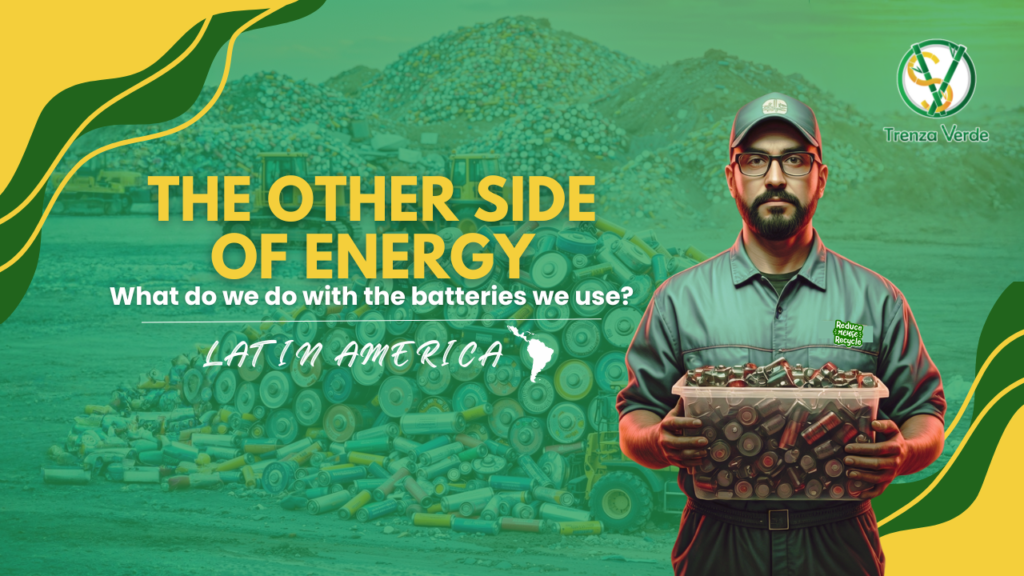Batteries: Small Powerhouses with a Big Environmental Story
Batteries are those tiny power sources that quietly keep much of our daily life running. From turning on the TV with a remote to keeping a child’s favorite toy alive, they’re everywhere. But here’s the catch: behind their small and simple appearance hides a heavy environmental footprint we often overlook.
In this article, we’ll dive into what really happens to batteries once their “life cycle” ends. Why should we care about something so ordinary and, at first glance, so insignificant? Because it can actually make a huge difference in the health of our planet.
Get ready to see batteries from a whole new perspective and understand their true impact.
Why Batteries Matter More Than We Think
Think about it: batteries make daily life easier—whether you’re at home or, in many rural areas, out in the fields where people still rely heavily on them for everyday tasks. But here’s the downside: every single used battery becomes waste. And if it isn’t disposed of properly, it can release heavy metals and toxic chemicals, contaminating both soil and water.
In other words, those small power packs can leave a very big stain on the environment.
The Current Landscape in Latin America
Now, let’s zoom in on what’s happening in Latin America. The truth is, the problem of used batteries here is huge. While exact data is hard to pin down for the entire region, estimates suggest that the collection and recycling rates hover at a shockingly low 3% to 5% in most countries. The rest? They usually end up in landfills—or worse, scattered in nature.
So, are we using more or fewer batteries today? Over the past decade, the use of traditional alkaline and button-cell batteries has dipped slightly, thanks to the rise of rechargeable devices like smartphones and laptops. But don’t be fooled—demand is still high when it comes to low-cost products, toys, and small household appliances. That means the environmental challenge hasn’t gone away.
How Are Batteries Being Managed in Latin America?
When it comes to used batteries, Latin America faces big challenges—but also big opportunities. Let’s break it down.
Post-Consumer Programs & EPR (Extended Producer Responsibility)
Across the region, we’re starting to see “post-consumer” collection schemes, where producers are made responsible for what happens after you toss out a battery. This usually means collection points in stores, schools, apartment buildings, and public offices, plus certified companies that handle safe transportation and treatment.
Some examples? Pilas con el Ambiente in Colombia or local municipal programs like ETAPA Cuenca in Ecuador.
Treatments & Recycling
Once collected, batteries are sorted by type—alkaline, zinc-carbon, NiMH, lithium-ion, button cells. Then they go through steps like neutralization or special recycling processes that recover valuable materials such as zinc, manganese, cobalt, or lithium. If recycling isn’t locally possible, they’re sent to controlled final disposal sites. Countries like Brazil and Mexico already have regulations guiding these steps.
Public Policy & Management
Compared to Europe or the U.S.—where Extended Producer Responsibility programs are solid and widespread—Latin America is still catching up. Progress has been slow and uneven, but change is happening.
Chile has its REP Law, which includes batteries as a priority product. Producers must organize and fund proper waste management.
Colombia has passed resolutions promoting selective collection and safe handling.
Mexico has local-level initiatives and collection programs through big retail chains, though a nationwide unified policy is still pending.
Innovation & Reduction: Where Are We Headed?
The truth is, recycling alone isn’t enough. The real solution is to reduce demand for disposable batteries and push for greener alternatives.
Innovation: Rechargeable batteries are becoming more common, and lithium-based models last much longer. These can be reused hundreds of times, cutting down on waste dramatically.
Eco-Design: More manufacturers are creating products that either don’t need disposable batteries at all or come with built-in rechargeable ones.
How Are Countries Encouraging This Shift?
Eco-design & chemical restrictions: Laws limit harmful substances like mercury, cadmium, and lead (Brazil’s CONAMA 401, Argentina’s Law 26.184, Mexico’s NOM-212). This discourages outdated, polluting tech and promotes rechargeable options.
EPR with targets: By making producers cover collection and treatment costs, companies are pushed to design longer-lasting, rechargeable, and recyclable products. This mirrors the new EU Battery Regulation, which is starting to influence the region.
Deposit-refund schemes (like in Chile): Pay a small deposit when buying a battery, then get it back when you return the used one. This system has boosted recycling rates elsewhere and is being considered in Chile.
Educational campaigns: Programs encourage consumers to switch to NiMH or Li-ion rechargeables for everyday devices and reduce single-use purchases.
What Can You Do?
At the end of the day, consumers like us hold the power to make a difference. Here’s how:
Choose rechargeables for high-use devices like remotes, flashlights, and kids’ toys. Fewer purchases mean less waste.
Handle with care: Don’t mix new and used batteries, or different types. Keep them away from heat and moisture.
Disposal matters: Never throw them in the trash or regular recycling bins. Always drop them at official collection points—check local programs.
Store safely: Cover the terminals of button or lithium batteries with tape, keep them in closed containers until you can recycle them properly.
Buy smart: Look for clear labels (chemistry, standards, date), and support brands that take part in EPR programs.
The Challenge and the Opportunity
Yes, collection rates are still low. But the winds of change are blowing. New decrees in Chile, stronger reverse logistics in Brazil, more collection points in Colombia, and fresh management plans in Mexico, Peru, Uruguay, and Argentina are moving the region forward.
The next big leap will come from ambitious targets, eco-modulated fees, deposit-refund systems, and mass education campaigns. Together, these steps can help us handle batteries in a way that protects both people and the planet.
📚 Further reading & sources to explore
ANDI – Grupo Retorna. (2025, mayo 28). Más de 7.000 puntos de acopio… ANDI
Baldé, C. P., et al. (2024). The Global E-waste Monitor 2024. United Nations University, UNITAR, ITU. E-Waste Monitor+1
Carey Abogados. (2025, agosto 1). Ministry of the Environment Requests Information… (Ley REP, fiscalización productores). Carey Abogados
Corporación Pilas con el Ambiente. (2024). Informe de Gestión 2024. pilascolombia.com
Diálogo Chino / Dialogue.Earth. (2025, mayo 6). Can battery recycling ease the pressures… (datos Olade, contexto crítico). Dialogue Earth
Grand View Research. (2025). Latin America battery market outlook 2023–2030. Grand View Research
IEA. (s. f.). Law 20.920 – Chile EPR framework (Policy Tracker). IEA
MMA Chile. (2024). Comité Operativo Ampliado – Baterías (presentación). Economía Circular
MMA Chile. (2025, mayo 28). Res. Ex. 3413/2025 – Propuesta de decreto de metas para Pilas y AEE. Economía Circular
MinAmbiente Colombia. (s. f.). Pilas y acumuladores – Programa posconsumo (normativa: Res. 1297/2010; 2246/2017). Ministerio de Ambiente

